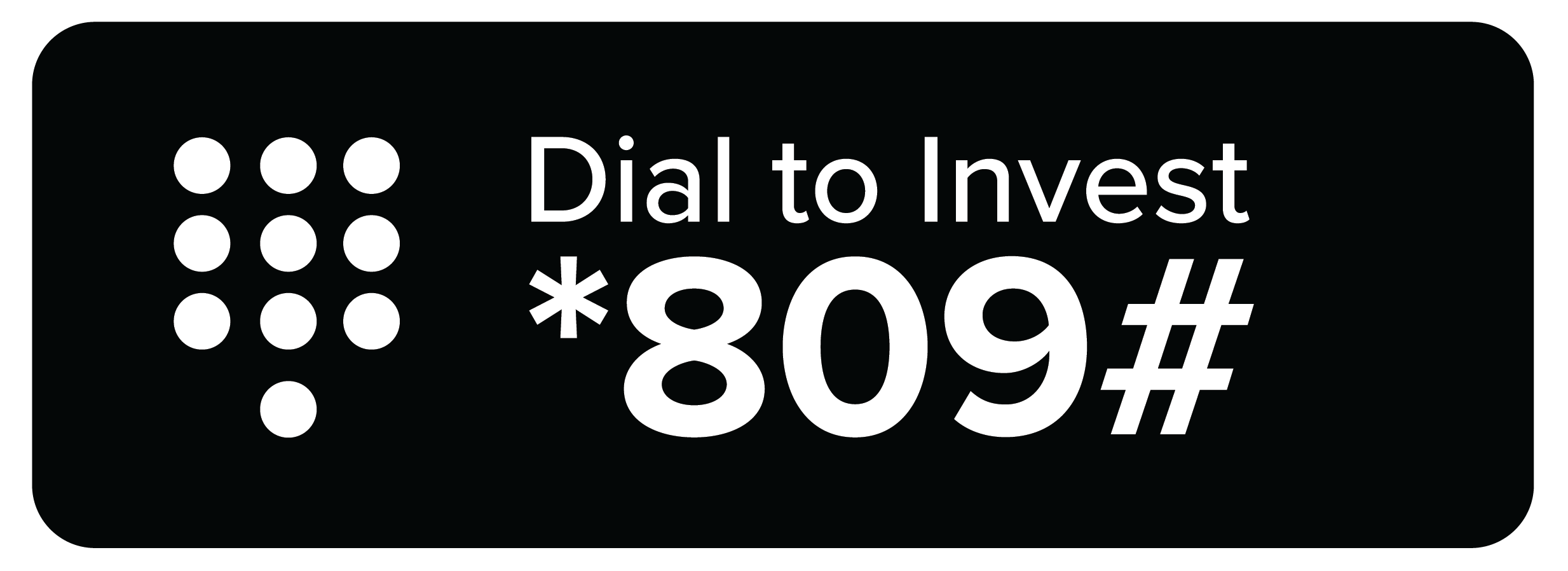The private sector contributes significantly to Kenya's economic growth, with increased access to credit driving real GDP expansion. Credit availability is essential for businesses to expand, innovate, and stay competitive. Recent data from the Central Bank of Kenya (CBK) shows that credit to the private sector contracted by 1.4% as of December 2024, reflecting the impact of exchange rate valuation effects on foreign currency-denominated loans due to the Shilling's appreciation, along with decreased demand driven by high lending interest rates. As the government aims to reduce its fiscal deficit, fostering a supportive environment for private sector growth, especially for micro, small, and medium enterprises (MSMEs), will be crucial for increasing revenue collection. Achieving this requires policy reforms to strengthen the credit market and the introduction of sector-specific funds to drive business growth in key industries like finance, agriculture, manufacturing, and transport. Compared to developed economies, Kenya's private sector faces limited credit access, relying heavily on commercial banks with minimal availability of alternative financing options such as venture capital, equity financing, or government-backed credit programs. Banks continue to be the primary source of business credit, supplying a total Kshs 3.9 trillion extended to the private sector as of December 2024, 81.2% of the total extended to the sector (inclusive of microfinances and SACCOs), with the highest allocations directed towards trade (17.6%), manufacturing (15.0%), and private households (14.8%).
In 2023, Kenya’s domestic credit to the private sector by banks to GDP ratio stood at 31.6%, indicating Kenya must enhance credit access for the private sector while also broadening the range of available credit sources to reduce its heavy dependence on the banking sector. Diversifying credit options will strengthen the support for businesses and improve overall financial resilience.
We have been tracking the evolution of Kenya’s private sector credit growth and below are the most recent topicals we have done on the subject:
- The State of Credit Availability in Kenya’s Private Sector - In September 2024, we highlighted Kenya’s state of lending to the private sector and gave our recommendations on what can be done to improve credit access to the private sector,
- The Hustler Fund- In December 2022, we highlighted the Financial Inclusion Fund, dubbed the “Hustler Fund” launched on 30th November 2022, aimed at improving credit access to citizens at the bottom of the pyramid who have often struggled to obtain affordable credit,
- Kenya’s Credit Reference Bureau Framework- Released in November 2022, this topical sheds more light on the Credit Reference Bureau (CRB) Framework in Kenya following the announcement by the Central Bank of Kenya that it had updated the Credit Information Sharing Framework in November 2022, which mandated the Credit Reference Bureaus (CRBs) not to use negative credit scores as the only reason to deny credit, and recommended the fast implementation of the risk based pricing model by commercial banks,
- Kenya’s Cost of Credit- Released in January 2022, the topical shed more light on Kenya’s high cost of credit remains with the big banks charging a higher cost of credit in comparison to smaller banks owing to their strong pricing power based on a wide distribution network, multiple services and well- established brands.
In this week’s topical, we shall focus on the status of Kenya’s private sector credit growth, highlighting the evolution and current state of lending to the private sector. We will provide specific recommendations on measures that can be implemented to improve credit access to the private sector. We shall do this by looking into the following:
- Introduction,
- The evolution of Kenya’s Private sector credit,
- Factors influencing private sector credit growth,
- Role of Government and its Impact on Private Sector Credit Availability
- Comparative analysis, and,
- Conclusion and Key consideration to improving private sector credit performance in Kenya
Section I: Introduction
The private sector comprises the segment of the economy operated and owned by individuals, partnerships, and corporations, rather than the government. Private sector credit refers to financial resources extended to these businesses by institutions other than central banks. This includes loans, trade credits, and non-equity securities that come with repayment obligations. In Kenya, primary providers of private sector credit include commercial banks, capital markets, SACCOs, microfinance institutions, and insurance companies.
Kenya's private sector is a key contributor to economic growth and job creation and is mainly composed of small and medium-sized enterprises (SMEs), which account for 90.0% of all private businesses and employ approximately 88.0% of the workforce. However, SMEs and informal enterprises often face significant difficulties in accessing credit due to banks' high-risk perceptions and the elevated costs of borrowing. These challenges have restricted business growth and reduced competitiveness. Unlike developed economies, where only 40.0% of business financing is sourced from banks and 60.0% from capital markets, Kenyan businesses are heavily reliant on banks, with 95.0% of their funding coming from this source and just 5.0% from capital markets, according to the World Bank. This reflects the limited availability of alternative financing options in the country.
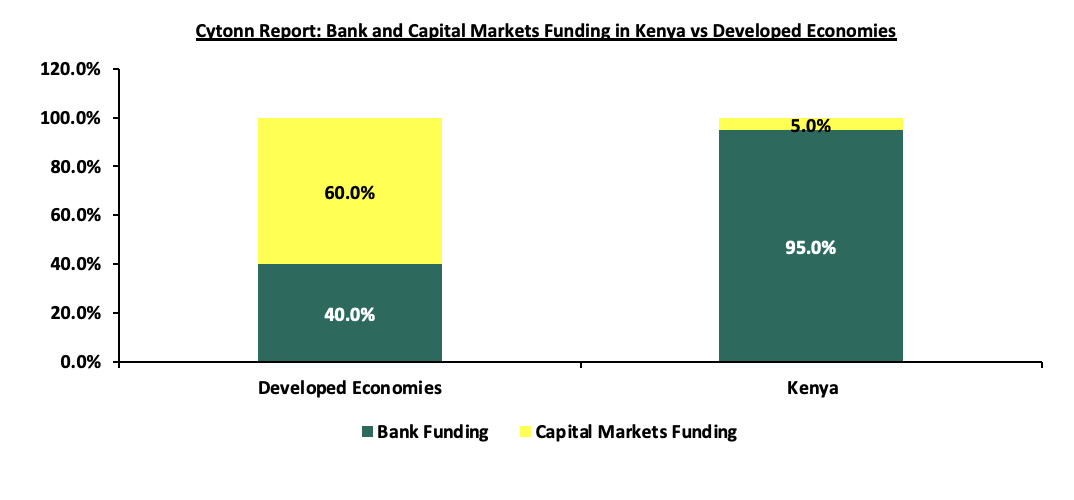
Section II: The evolution of Kenya’s Private sector credit
- Private sector credit Growth
Over the last five years, there has been consistent growth in private sector lending, with the total credit extended to the private sector by banks increasing at a 5-year CAGR of 6.5%, to Kshs 3.9 tn in December 2024 from Kshs 2.8 tn in December 2020, in line with the relative economic growth averaging at 4.8% for the last 5 years. The graph below shows the cumulative private credit over the period under review from the banking sector;
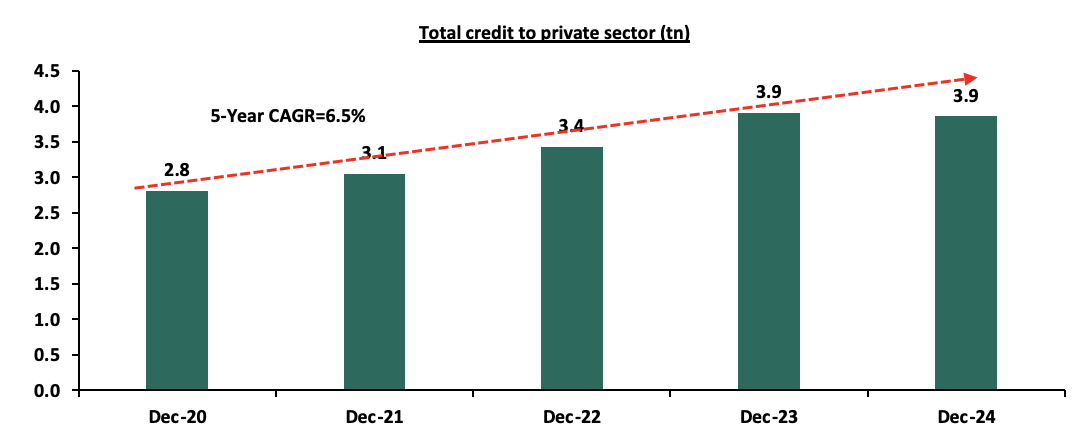
Source: Central Bank of Kenya
The banking sector remains the dominant lender in Kenya's private sector, accounting for 81.2% of total private sector credit equivalent to Kshs 3.9 trillion as of December 2024. SACCOs and microfinance institutions provided the remaining 18.8%, equivalent to Kshs 0.9 trillion. Notably, the contribution from SACCOs and microfinance has been gradually increasing, rising by 1.9% points from 16.9% in December 2023. As of December 2024, private households received the largest share of private sector credit at Kshs 1,317.4 billion, representing 34.1% of the total Kshs 3,857.7 billion extended. Within the banking sector, the trade sector attracted the most credit, amounting to Kshs 678.8 billion or 16.9% of total bank lending. This was followed by the manufacturing sector and private households, which received 15.0% and 14.8% of total bank credit, respectively.
Year-on-year, the private households sector saw the highest credit growth, expanding by 9.2% to Kshs 572.3 billion from Kshs 524.1 billion in December 2023. The mining and quarrying sector also experienced notable decline, with credit decreasing by 22.7% to Kshs 20.1 billion from Kshs 26.0 billion over the same period. The graph below illustrates the cumulative private sector credit over the past four years, comparing contributions from banks, SACCOs, and microfinance institutions.
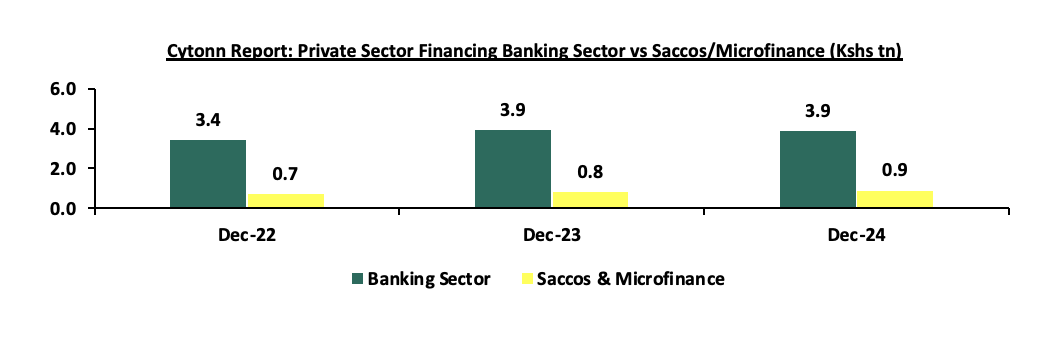
Source: Central Bank of Kenya
Private sector credit growth from the banking sector has been on an downward trajectory in 2024, contracting by 1.4% in the 12-months to December 2024 compared to 13.9% in December 2023.This decline is mainly due to the reduced borrowing capacity of businesses and households, driven by higher interest rates seen in 2024 and the lower disposable income. To combat inflation and stabilize the currency, the Central Bank of Kenya (CBK) adopted for a tighter monetary policy, increasing the Central Bank Rate (CBR) by 50 basis points to 13.00% in February 2024, from 12.50%. The rate was subsequently maintained at 13.00% during the CBK's April and June meetings. As a result, borrowing costs rose, making loans more expensive and reducing demand. However, since August, CBK’s actions has since been reversed with the aim of spurring the growth of the economy, by lowering CBR Rates to present 10.75% in February 2025, a total of 225.0 bps from 13.00% in June 2024. This reduction in the CBR rates will release additional liquidity to banks.
Additionally, in February 2025, CBK reduced the Cash Reserve Ratio (CRR) by 100.0 basis points to 3.25% from 4.25% in order to compliment the lowering of CBR by releasing additional liquidity to the banks. This is expected to have increased liquidity available to commercial banks for lending to the private sector, and thus support growth of credit to the sector. Credit contraction was primarily driven by sectors such as Mining and Quarrying, Finance and Insurance, Other activities, and Manufacturing, which recorded year-on-year decline rates of 22.7%, 21.2%, 18.1%, and 9.4%, respectively. On the other hand, Private households, Agriculture, Consumer durables sector and Trade sectors experienced growth in credit uptake, with year-on-year growth of 9.2%,5.2%,3.3% and 2.3%, respectively. Additionally, the continued rise in gross non-performing loans (NPLs) has led to increased caution among lenders in specific sectors. Elevated NPL levels have heightened the risk profile for banks, with total gross NPLs reaching Kshs 672.6 billion in December 2024, representing 8.3% increase from Kshs 621.3 billion in December 2023. As such, despite the notable decrease in the CBR, banks have been reluctant in lowering their lending rates, coming in at 16.4% as of February 2025, which has necessitated the CBK to take up measures to lead banks into lowering their lending rates. The table below shows the sectoral credit uptake growth on y/y and year-to-date basis from the banking sector:
|
Cytonn Report: Sectoral Credit Uptake (Kshs bn) |
|||||
|
Sector |
Dec-23 |
Jan-24 |
Dec-24 |
Last 12 Months Change (%) |
YTD change (%) |
|
Private households |
524.1 |
552.8 |
572.3 |
9.2% |
3.5% |
|
Agriculture |
141.8 |
150.9 |
149 |
5.1% |
(1.3%) |
|
Consumer durables |
415.5 |
417.1 |
429.2 |
3.3% |
2.9% |
|
Trade |
663.4 |
667.6 |
678.8 |
2.3% |
1.7% |
|
Transport & communication |
361.4 |
352 |
367.2 |
1.6% |
4.3% |
|
Real estate |
452.5 |
457.5 |
458.4 |
1.3% |
0.2% |
|
Business services |
214.8 |
217.5 |
205.1 |
(4.5%) |
(5.7%) |
|
Building and construction |
143.3 |
136.4 |
134.5 |
(6.1%) |
(1.4%) |
|
Manufacturing |
636.7 |
644.1 |
577.1 |
(9.4%) |
(10.4%) |
|
Other activities |
142.7 |
141.1 |
116.8 |
(18.1%) |
(17.2%) |
|
Finance & insurance |
189.1 |
159.1 |
149.1 |
(21.2%) |
(6.3%) |
|
Mining and quarrying |
26 |
24.4 |
20.1 |
(22.7%) |
(17.6%) |
|
Total credit growth |
3911.3 |
3920.5 |
3857.6 |
(1.4%) |
(1.6%) |
Source: Central Bank of Kenya
Kenya's private sector credit growth has remained subdued even after the interest rate cap was removed in November 2019. Although the interest rate cap was initially introduced to regulate lending rates, it led to a contraction in credit supply as banks faced reduced profit margins in a more challenging lending environment. However, with expectations for the shilling to remain strong and inflationary pressures in check, the private sector credit growth is expected to improve by the end of 2025. Additionally, the CBK's move to reduce the central bank rate by 225.0 basis points to 10.75% during its February 2025 meeting from 13.0% in June 2024, combined with the expected gradual easing of monetary policy, and a further decrease in the CRR, is likely to encourage private sector borrowing. With lower interest rates, both businesses and households are expected to access more affordable credit, leading to a rebound in private sector credit growth and offsetting some of the slowdown observed in the first half of the year of 2024. The chart below shows the movement of the private sector credit growth:
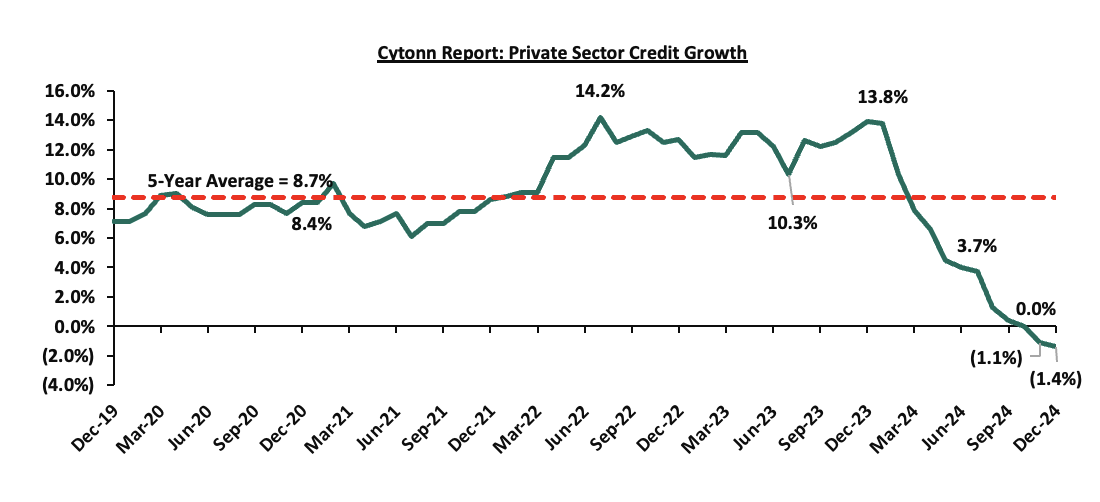
Source: Central Bank of Kenya
Section III: Factors influencing private sector credit growth
Private sector credit uptake is influenced by a number of factors which include;
- Interest rates – Interest rates set by central banks and financial institutions play a significant role influencing the credit market. On the demand side, higher interest rates increase both borrowing costs and debt servicing expenses, limiting the capacity of businesses and individuals to take on additional credit. By February 2025, the average lending rate stood at 16.4%, reflecting an increase of 0% points from 15.9% in February 2024. The Central Bank of Kenya's (CBK) decision to raise the CBR by 50 basis points to 13.00% in February 2024 and maintain it in subsequent meetings until August 2024 tightened liquidity, prompting commercial banks to raise lending rates to cover the increased cost of funds. However, with the CBK lowering the CBR by 50 basis points to 10.75% in February 2025 and further gradual rate cuts anticipated, borrowing conditions are expected to ease, potentially stimulating credit growth in the coming months.
- Elevated Credit Risk which contributes to high risk premiums – The high-risk perception prompts lenders to incorporate risk premiums into the interest rates they charge on loans resulting in higher borrowing costs for individuals and businesses seeking credit. The risk premium acts as a cushion for lenders against potential losses, reflecting the level of uncertainty and perceived risk associated with the borrower. Additionally, according to the Central Bank of Kenya (CBK), Credit risk remained elevated with Gross Non-Performing Loans (NPLs) to Gross Loans Ratio standing at 16.4% at the end of December 2024, a 1.6% points increase from 14.8% recorded at the end of December 2023, attributable to a lower increase in gross NPLs of 0.6% compared to an increase in gross loans of 1.8%. The graph below shows the movement for the years under review;
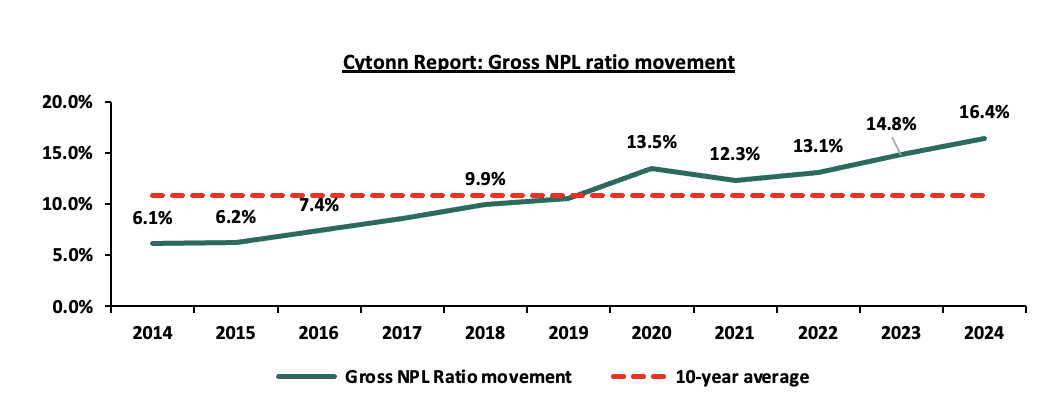
|
Domestic Public Debt by Holder (Percent) |
||||||||
|
|
Dec-18 |
Dec-19 |
Dec-20 |
Dec-21 |
Dec-22 |
Dec-23 |
Dec-24 |
Mar-25 |
|
Banking Institutions |
54.2% |
54.3% |
52.8% |
50.2% |
46.8% |
46.1% |
45.1% |
45.3% |
|
Insurance companies |
6.5% |
6.4% |
6.4% |
6.8% |
7.4% |
7.2% |
7.3% |
7.2% |
|
Parastatals |
6.7% |
6.5% |
5.7% |
5.6% |
6.1% |
5.5% |
5.6% |
6.1% |
|
Pension funds |
28.2% |
28.6% |
30.3% |
31.3% |
33.3% |
29.9% |
28.9% |
28.4% |
|
Other investors |
4.4% |
4.2% |
4.7% |
6.0% |
6.4% |
11.3% |
13.2% |
13.1% |
- Technological Advancements – Technological innovations, including Fintech solutions and mobile banking systems, have significantly enhanced digital lending. Mobile money platforms, in particular, have made credit more accessible, especially for individuals without conventional banking relationships, fostering a more inclusive financial landscape. These advancements highlight the growing role of technology in shaping the future of credit accessibility in Kenya. As digital financial services continue to advance, an increasing number of businesses and individuals can secure the funding they need for growth, ultimately contributing to the country's overall economic development.
- Inflation rates – Rising inflation led the Central Bank of Kenya to implement a tighter monetary policy, driving up borrowing costs for both businesses and households. As lending rates increased, access to credit became more expensive, discouraging many from taking on new loans. This resulted in a slowdown in private sector credit growth, particularly in industries such as manufacturing and trade, which faced challenges in financing operations and investments due to higher debt servicing costs.
However, the Monetary Policy Committee's interventions effectively brought inflation down to 3.5% in February 2025, within the target range of 2.5%–7.5%, compared to a high of 9.2% in February and March 2023 Additionally, the Purchasing Managers Index (PMI) rose to 50.6 in February 2025, up from 49.8 in January 2024, signalling an improving business environment. With inflationary pressures easing, a more favourable credit environment is expected, encouraging businesses and households to seek financing as they anticipate lower interest rates.
- Over-reliance on the banking sector – Historically, banks have played a dominant role in providing credit to the private sector, accounting for 95.0% of total lending as of December 2024. This heavy reliance on banks has resulted in a lack of diversification in funding sources for businesses. To foster a more resilient and well-rounded credit ecosystem, it is crucial to explore alternative financing options such as capital markets and non-banking financial institutions. To mitigate the systemic risks associated with overdependence on the banking sector, the government should implement strategies to strengthen other financial sectors, including leasing, venture capital funds, development finance institutions, and bond and equity markets. Creating an enabling environment for these alternatives would promote a more balanced and inclusive approach to credit access, and,
- High cost of credit –Borrowing comes with additional overhead costs beyond interest charges, including bank fees, legal fees, government levies, valuation fees, and insurance, all of which are the borrower's responsibility. These extra expenses raise the overall cost of credit, making borrowing more expensive and ultimately reducing demand for credit within the private sector.
Section IV: Role of Government and its Impact on Private Sector Credit Availability
Impact of the Government on the Private Sector
The government of Kenya plays a crucial role in shaping the environment for private sector credit availability. The following are some of the ways in which the Kenyan Government impacts the flow of credit to the private sector;
- Government's Fiscal Policy and Debt Management
The government’s fiscal policy, particularly its domestic borrowing practices, has a profound effect on private sector credit availability. Heavy government borrowing from the domestic market competes with private sector borrowers for available credit, leading to a crowding-out effect. This occurs when increased government borrowing reduces the funds available for businesses, thereby driving up interest rates and limiting access to affordable credit. As a result, private sector investments are constrained, and financial market stability may be threatened. According to the Central Bank of Kenya (CBK), gross government domestic debt has grown at a 10-year Compounded Annual Growth Rate (CAGR) of 14.4%, reaching Kshs 5.9 tn in 2024 from Kshs 1.5 tn in 2015. The chart below shows the steady growth of gross domestic debt over this period;
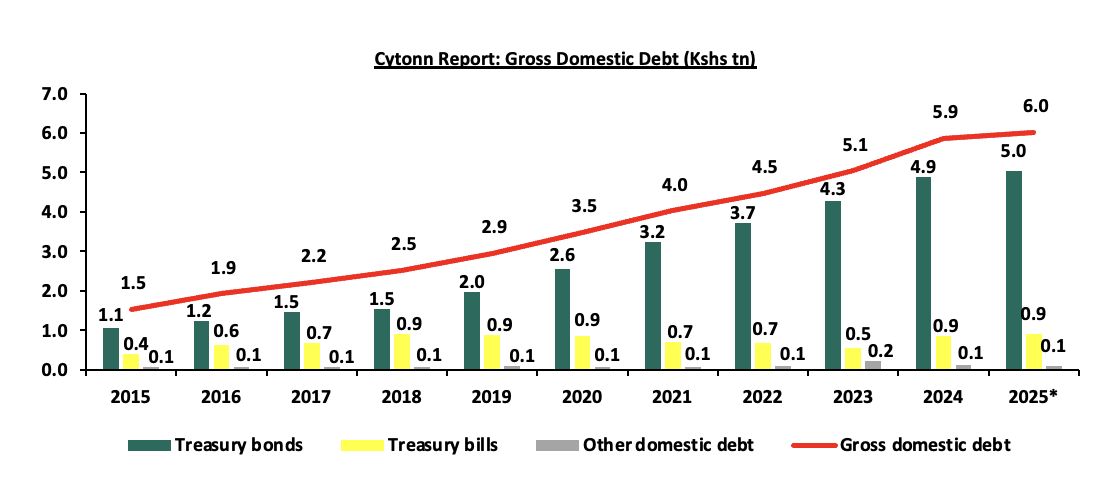
Source: Central Bank of Kenya (CBK)
*data as of 14 th March, 2025
Additionally, as of 14th March 2025 commercial banks held an average of 45.3% of this domestic debt, heightening the risk of crowding out the private sector, as banks prefer lending to the government over private businesses, especially during downturn economic times. The chart below highlights the distribution of government debt holdings across various institutions;
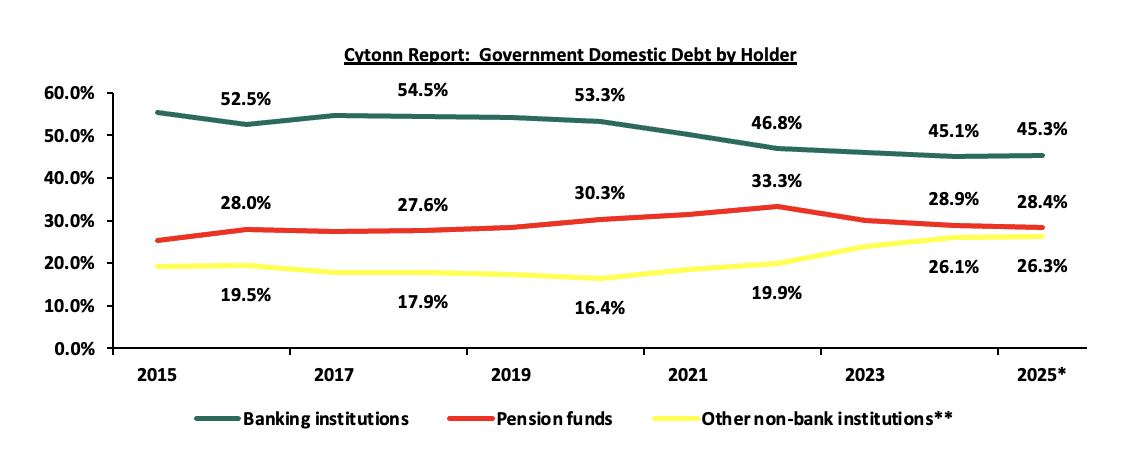
Source: Central Bank of Kenya (CBK)
*data as of 14 th March, 2025
**Others include insurance companies, parastatals and retail holders
- Regulatory Framework
The regulatory framework plays a crucial role in shaping credit availability. The CBK, through capital adequacy requirements and liquidity management rules, ensures that banks have enough funds to support private sector lending while maintaining stability. For instance, the recent proposal by the National Treasury to review the minimum core capital requirement for commercial banks to Kshs 10.0 bn, up from the current Kshs 1.0 bn, is expected to strengthen the resilience of banks, enabling them to better absorb risks and extend more credit to the private sector. However, this could also reduce competition if smaller banks struggle to meet the new requirement, potentially limiting credit options for some businesses in the short term.
Additionally, the integration of Credit Reference Bureaus (CRBs) has allowed lenders to assess the creditworthiness of businesses and individuals, improving access to credit while managing risk exposure. By tailoring credit assessments to individual borrower profiles, the regulatory framework promotes a more informed lending environment, benefiting both banks and the private sector.
- Monetary Policy
The Central Bank of Kenya’s monetary policy, particularly its Central Bank Rate (CBR), directly influences borrowing costs. The relationship between the Central Bank Rate (CBR) and the commercial bank's lending rates is crucial in understanding credit accessibility in Kenya's private sector. The CBR, set by the Central Bank of Kenya, acts as a benchmark for determining the cost of borrowing in the market, and fluctuations in this rate tend to influence the interest rates that commercial banks apply on loans.
The Central Bank Rate (CBR) remained steady at 10.5% from July 2023 through November 2023. However, in December 2023, the CBR was adjusted upward by 200 basis points to 12.5%, indicating a tightening of monetary policy. By February 2024, the CBR further increased by 50 basis points to 13.0%, a rate it maintained through July 2024. Simultaneously, from February 2024 to February 2025, the average lending rates by commercial banks showed a consistent upward trend, to 16.4% by February 2025 from 15.9% recorded in February 2024. This increase in lending rates reflects the rising cost of credit over the year. As the CBR increased, commercial banks adjusted their lending rates upwards, leading to higher borrowing costs for the private sector. This rise in interest rates has had a direct impact on the private sector's ability to access credit, as higher costs may discourage businesses from taking out new loans for expansion or operations. The chart below shows the trend in commercial banks weighted average lending rates between February 2024 and February 2025;
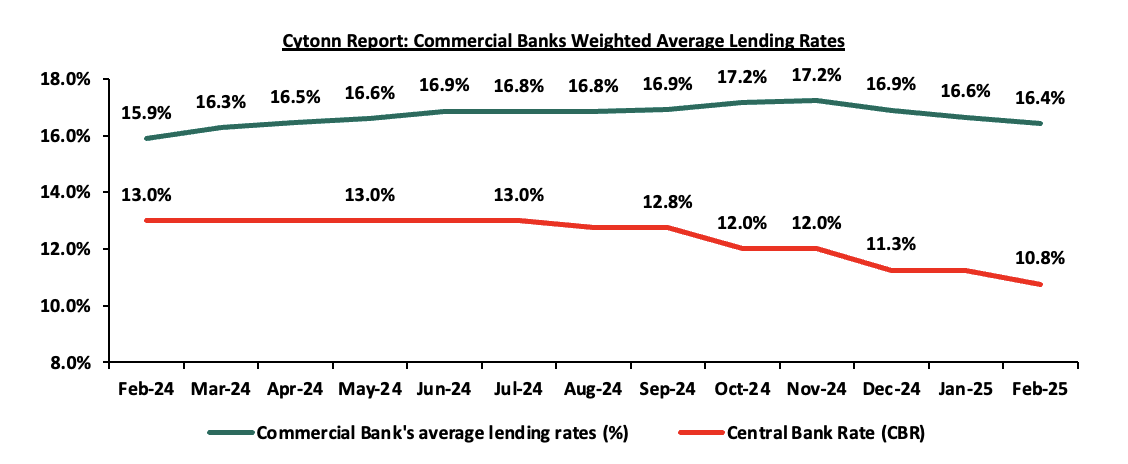
Source: Central Bank of Kenya (CBK)
The steady increase in lending rates, coupled with the rise in the CBR, posed challenges for private sector credit growth. Higher borrowing costs constrained investment and expansion activities within the private sector, particularly for small and medium-sized enterprises (SMEs), which are more sensitive to interest rate changes. However, in a move signaling a gradual easing of monetary policy, the Central Bank of Kenya further lowered the Central Bank Rate (CBR) by 225.0 basis points to 10.75% during its February 2025 meeting from 13.0% in June 2024,influencing the rates to go down by 50 basis points to 16.4% February 2025 from 16.9% in June 2024.This reduction in the CBR is expected to support credit growth and ease financial pressures on borrowers, providing much-needed relief to businesses in the private sector.
- Initiatives placed by the government and CBK to promote private sector credit growth
Based on the importance on private sector contribution to GDP, the Central Bank of Kenya (CBK), in collaboration with other stakeholders, has implemented various measures ranging from licensing of new products, technological innovations and public education to promote credit growth in Kenya. Some of the initiatives include;
- Licensing of Innovative Financial Products – By facilitating the introduction of innovative lending solutions, investment tools, and financial products, the central bank has played a key role in broadening credit access for businesses and individuals. Notably, in October 2024, the Central Bank of Kenya (CBK) approved licenses for 27 additional Digital Credit Providers (DCPs), increasing the total number to 85, following the licensing of 7 DCPs in June 2024. This initiative aligns with CBK’s strategic commitment to enhancing credit availability in the private sector by fostering and expanding digital lending options.
- Diversifying Funding Strategies – Through incorporating alternative borrowing strategies, the government aims to reduce its reliance on domestic credit from commercial banks, and as a result, enhancing the ease of credit access to the private sector. Sourcing of alternative funding by the government mitigates the pressure on the local credit market, creating room for private sector entities to secure loans more easily. Notably, Eurobonds, as a form of commercial borrowing, have been a significant component of the government's debt strategy. However, by exploring concessional options, the government not only broadens its funding sources but also ensures a balance that is more conducive to a sustained economic growth,
- Boosting Liquidity in the Banking sector- In February 2025 the CBK reviewed the Cash Reserve Ratio to 3.25%, from the existing 4.25% to compliment lowering of the CBR rate. This adjustment is expected to release additional liquidity to banks and hence it’s expected to lower the cost of funds as well as the lending rates, and thus support growth of credit to the private sector.
- Empowering MSMEs through the Credit Guarantee Scheme (CGS) Regulation 2020 – MSMES, being one of the largest sectors in the private sector plays a vital role in the enhancing economic growth of the Country. The implementation of the Credit Guarantee Scheme (CGS) Regulation in 2020, facilitated 2,609 business access loans to MSMEs totalling Kshs 4.1 bn as of August 2022 surpassing its initial capital of Kshs 3.0 bn. Key to note, 60.0% of the beneficiaries were small enterprises, while micro and medium enterprises accounted for 25.0% and 15.0% respectively. Additionally, in celebration of the Hustler Fund's second anniversary, the government launched a new product for Small and Medium Enterprises (SMEs), targeting 2.0 bn beneficiaries with strong credit histories. The initiative aims to boost financial inclusion by providing tailored credit solutions to help SMEs grow and integrate into the formal banking sector. Complementing the Credit Guarantee Scheme, this product is expected to further support MSME growth and financial inclusion,
- Implementation of the Financial Inclusion Fund - The Financial Inclusion Fund, commonly known as the Hustler Fund, is a government-sponsored initiative aimed at providing low-income Kenyans with convenient access to credit through their phones. Launched in November 2022, the primary objective of the Hustler Fund is to make credit affordable to a significant portion of the population that has long been excluded from formal credit systems. The introduction of the Hustler Fund underscores the government's commitment to enhancing financial inclusion and expanding access to credit,
- Other government special Funds – Under the Public Finance Management Regulations, the government introduced various loan programs aimed at empowering women, youth, and persons with disabilities (PWDs), including the Youth Development Fund, Uwezo Fund, and Women Enterprise Fund. These initiatives are designed to expand credit access for marginalized and underserved groups, aligning with broader efforts to promote private sector credit growth by addressing financial barriers faced by these special groups.
Additionally, the banking system has put in place measures to aid private sector credit growth such as;
- Tailoring Credit with Risk-Based Pricing – The Central Bank of Kenya approved risk-pricing models for 22 out of the 38 commercial banks as a measure of tailoring loans to a customer’s financial profile while helping banks and other lenders to manage their risk exposure. The initiative has continued to increase credit accessibility to the private sector based on an individual financial profile in terms of borrowing and repayment history, and,
- Digital Transformation – Most Kenyan banks have embraced digital technologies, streamlining and expediting the loan application and approval processes. The implementation of user-friendly mobile and online platforms facilitates quicker access to credit, enhancing the efficiency of transactions for businesses and individuals. Banks such as KCB and NCBA partnered with Safaricom to offer the overdraft credit facility of Fuliza in increasing credit lending to SMEs. Additionally, KCB has the VOOMA app specifically targeting lending to small and medium enterprises.
Section V: Comparative analysis
According to the World Bank, Kenya’s domestic credit extended to the private sector outperformed majority of the Sub-Saharan countries. The Kenya’s domestic credit extended to private sectors as a percentage of the GDP came in at 31.6%, 1.8% points lower than the average Sub-Saharan domestic credit to private sectors lending which stood at 33.4% in the same period. Although Kenya outperformed majority of Sub-Saharan countries in credit extended to the private sector, the country still underperformed against developed economies. The graph below shows domestic credit extended to the private sector over the years and a comparison of Kenya’s performance against selected economies;
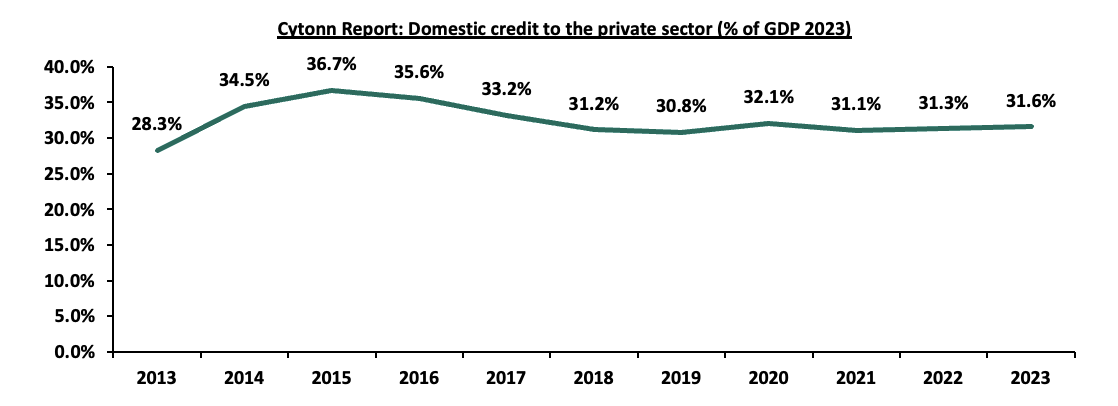
Source: World Bank
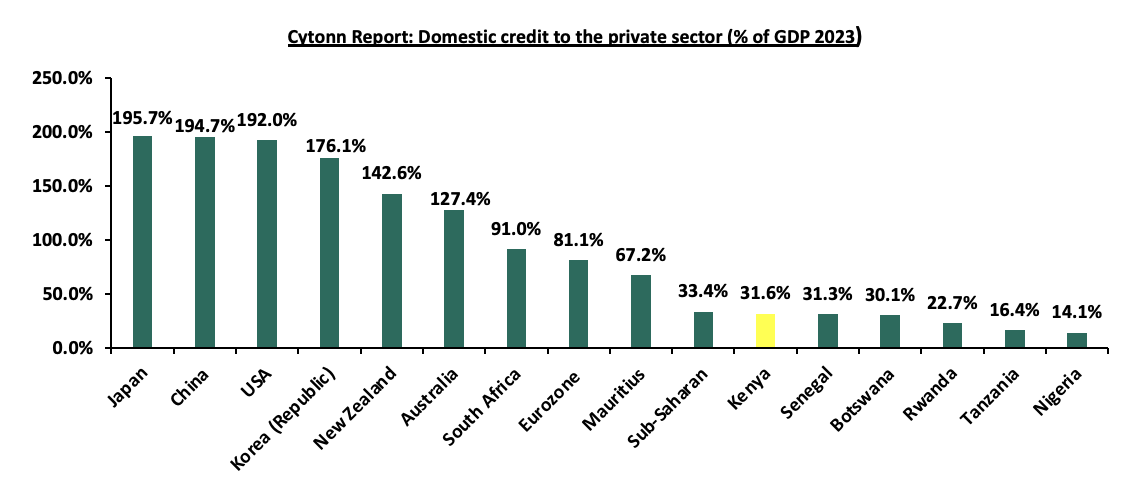
Source: World Bank
Different developed countries have adopted different measures in enhancing private sector credit growth. Some of the successful measures include:
- Project Finance Structuring-This financing method leverages a project’s own operating cash flow and assets to mitigate investment risks and secure funding at a lower cost. A notable historical example is China’s 1997 initiative, where Plantation Timber Products (Hubei) Ltd launched a USD 57.0 mn greenfield project to install modern medium-density fiberbroad plants in interior China. The International Finance Corporation (IFC) played a pivotal role by arranging USD 26.0 mn in syndicated loans, utilizing the limited-recourse nature of project finance. At the time, foreign commercial banks were hesitant to invest in China’s less-developed interior provinces, making this a pioneering effort.
- Universal Supervisory Body to Monitor Fund Disbursements- The United Kingdom’s British Business Bank (BBB) exemplifies this measure by overseeing government-backed funding programs such as the Enterprise Finance Guarantee Scheme (EFGS), the British Growth Fund (BGF), the Funding for Lending Scheme (FLS), and the Start Up Loans Scheme (SLS). The BBB ensures accountability and transparency in fund allocation, fostering trust among private sector participants and encouraging credit uptake.
Section VI: Conclusion and Key Considerations
The private sector is a significant contributor to the Kenyan GDP. However, credit availability remains a major hindrance for the sector’s growth. To offset the downside, the government of Kenya needs to adopt or emulate the funding model used by the developed economies in creating an enabling environment for two or more players to compete within the Kenyan credit market. Currently, the credit market is dominated by commercial banks while the Capital markets and other sources contribute the remaining 54.8% of funding to all businesses. Additionally, the government needs to adopt a consumer-centred approach for borrowing to encourage private sector credit demand. We believe that additional measures need to be implemented in order to promote private sector credit growth. Below are some of the initiatives that the government can adopt;
- Developing the capital markets to expand alternative financing options - The Kenyan credit market is largely dominated by commercial banks, leaving businesses with limited funding choices. Strengthening the bond and equity markets can offer long-term financing solutions for businesses. Regulatory improvements, tax incentives for investors, and awareness campaigns can encourage more companies to raise capital through these markets, reducing reliance on bank loans. Additionally, the government can promote fintech solutions and digital lending platforms to increase accessibility to credit.
- Enhancing financial inclusion and credit awareness - Many small businesses struggle to access credit due to a lack of financial literacy and poor credit histories. Nationwide financial literacy programs can equip businesses with the knowledge to manage credit effectively and improve their creditworthiness. The government, in collaboration with financial institutions, can also develop tools to help businesses understand their credit scores and improve their financial planning.
- Enhancing oversight on government-backed fund initiatives to promote transparency - Government-backed funds such as the Hustler Fund, Uwezo Fund and Youth Enterprise Development Fund play a crucial role in financing small businesses. However, their effectiveness depends on transparency and accountability. Establishing independent monitoring bodies to oversee fund distribution, regularly publishing reports on disbursements and setting clear eligibility criteria can enhance trust and efficiency in these programs.
- Encouraging sector-specific credit policies - Some industries, such as agriculture and manufacturing, require specialized financial products tailored to their unique needs. The government can work with financial institutions to develop sector-specific loan products with favorable terms, such as lower interest rates and longer repayment periods, to support key industries that drive economic growth.
- Strengthening credit guarantee schemes - Many businesses fail to secure loans due to a lack of collateral. Expanding credit guarantee schemes and partnering with financial institutions can help mitigate lender risk to provide loans to SMEs. The government can enhance existing guarantee programs that back a portion of the loans given to small businesses, reducing the perceived risk for lenders.
- Diversify Funding Sources Beyond Banks: To reduce the overreliance on banks for credit, it is essential to develop and expand access to capital markets. Encouraging businesses and individuals to explore alternative financing options, such as corporate bonds, venture capital, and equity financing, will improve financial flexibility and foster economic resilience.
The outlook for private sector growth in Kenya reflects a promising landscape marked by resilience, innovation and a proactive policy environment. The sector remains a cornerstone of economic progress, creating jobs, fostering entrepreneurship and driving innovation. While challenges such as limited credit access have persisted, recent macroeconomic developments signal a more favorable environment for growth. Recent monetary policy adjustments by the Central Bank of Kenya (CBK) have created a favorable environment for private sector credit growth. In February 2025, the CBK lowered the Central Bank Rate (CBR) to 10.75% from 11.25%, and a total of xx bps from a high of 13.00%, which has begun to reduce borrowing costs, making credit more accessible to the private sector. These measures, combined with stable inflation, currently at 3.5% and stable currency, are expected to improve the private sector credit growth. However, sustainable growth requires ongoing collaboration between the government, businesses, and stakeholders to address barriers, enhance infrastructure, and cultivate a conducive business environment. With strategic initiatives and a commitment to fostering inclusive growth, Kenya's private sector is poised to play a pivotal role in shaping the nation's economic success. we are of the opinion that the initiatives already put in place by the government to promote access to credit by the private sector coupled with creating an enabling operating business environment for alternative credit sources will come in handy in promoting credit growth in the private sector. We expect sustained growth in the lending to the private sector on the back of the existing policies aimed at enhancing credit uptake which in turn will contribute to country’s economic growth.
Disclaimer: The views expressed in this publication are those of the writers where particulars are not warranted. This publication, which is in compliance with Section 2 of the Capital Markets Authority Act Cap 485A, is meant for general information only and is not a warranty, representation, advice or solicitation of any nature. Readers are advised in all circumstances to seek the advice of a registered investment advisor



